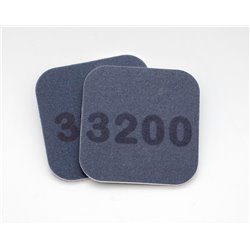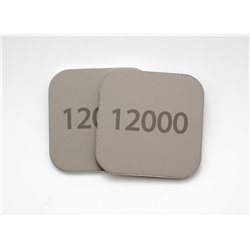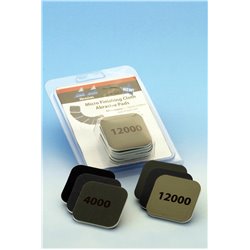Static grass puffer bottles work by manually charging model grass fibres with static electricity. When the charged...
No products
Product successfully added to your shopping cart
There are 0 items in your cart. There is 1 item in your cart.
Search Tips
What are sanding pads?
Sanding pads are an essential tool to refine and perfect the surface of their models. These flexible abrasive pads are designed to smooth out imperfections, seams and excess material that may result from cutting, gluing, or casting processes. Unlike traditional sandpaper, sanding pads are generally more pliable, allowing them to conform to the intricate curves and details often found in miniature models, from aircraft and cars to figures and ships.
Even the smallest bumps, seams, or uneven edges can detract from the overall appearance of a model. Sanding pads come in various grit levels, from coarse to very fine, enabling modellers to address different stages of the smoothing process. Coarse pads (with a lower grit number) are useful for initially shaping rough areas or removing larger amounts of material, while fine-grit pads (with a higher grit number) are ideal for polishing surfaces to a smooth finish before painting or detailing.
One of the major advantages of sanding pads is their flexibility. Unlike rigid sanding sticks or files, these pads can be used on curved surfaces without risking the loss of delicate details. This makes them particularly useful for working on rounded or complex shapes such as aircraft fuselages, car bodies, or human figures, where maintaining the integrity of the original mould is essential. The soft backing of the pads allows modellers to sand without exerting too much pressure, which reduces the risk of damage or unintentional reshaping.
Sanding pads can also be used wet or dry, offering versatility depending on the material and finish required. Wet sanding, often employed in the finer stages of finishing, helps reduce dust and provides a smoother result. Using water as a lubricant prevents the abrasive particles from clogging up, ensuring a more consistent and efficient sanding process. Additionally, wet sanding is ideal when working on resin or plastic kits, as it minimises the chances of scratching or leaving visible marks.
In terms of grit range, many modellers opt for a progression from coarser to finer pads during the build process. This gradual transition from rough shaping to final smoothing helps to create a flawless surface, preparing the model for painting or applying decals. A common grit range for modelling might start from around 150-200 for rougher work, progressing up to 1000 or even higher for fine polishing. Some sanding pads can even go up to micro-mesh grades, which are used for an ultra-smooth, glass-like finish on transparent parts like aircraft canopies.
While sanding pads are often associated with larger surface areas, they can be cut to size for more intricate work. Many modellers keep a variety of pad sizes on hand, from large sheets for broad areas to tiny squares or strips for reaching into small corners or tight spaces. This adaptability makes sanding pads a versatile addition to any modeller's toolkit, whether you're working on a military diorama, a racing car, or a fantasy figure.
Overall, sanding pads are indispensable for achieving professional-quality finishes in scale modelling. They provide the necessary precision and flexibility to refine surfaces without compromising detail, ensuring your model looks its best once fully assembled and painted. Whether you're a beginner or an experienced modeller, having a selection of sanding pads will greatly enhance your ability to achieve smooth, seamless results.
Click here to receive the tips weekly in your mailbox. You can unsubscribe at any time.










